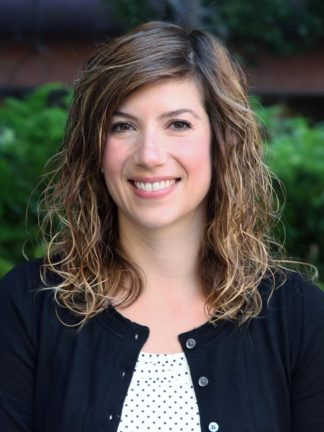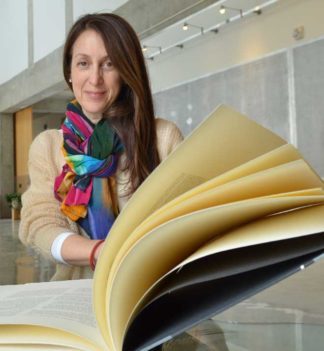By Allison Campbell-Jensen
In the ancient Greek play “The Bacchae,” a group of women called the Maenads worship Dionysus, the god of wine and theater. Discussing the play in a Rarig classroom, with some theater students in-person and some on Zoom, they talked about the Maenads’ joy in being in a sisterhood. Yet, so much of their time is spent under the influence.
“He gave us a way to escape our pain, so we worship him,” one said. “Ecstasy is a way not to feel pain,” another said. “Like a medicine,” the first student added.
They are exploring the intersection of pharmacy and theater in the class titled “Pharmakon: Performing Science,” taught by theater faculty Sonja Kuftinec and Luverne Seifert, and graduate assistant Michael Valdez, and pharmacy faculty Paul Ranelli. Pharmakon is an ancient Greek word, Kuftinec says, that means simultaneously poison, healing, and scapegoat.
“It’s the root of ‘pharmacy’ and of the dramatic explorations we’re engaging around pain, healing, theories of disease, and the social systems within which pharmacy operates,” she says. Additional pharmacy faculty are among their guest instructors for this spring semester course, which the syllabus describes as a trip.
Librarians’ role
Librarians Sarah Brown (Pharmacy) and Deborah Ultan (Theater Arts) collaborated with the faculty in creating the course. Originally, the team had applied to be part of a “research sprint,” in which they would spend an intense week working with librarians to leverage their expertise. Getting together in May 2020 was not possible, however, so instead Brown and Ultan took a slow walk with the faculty, meeting with them a dozen times over the summer and fall.
“While we weren’t able to replicate a research sprint,” Brown says, “it was a really valuable experience.” Ultan enjoyed it: “That we turned this into a slow walk actually allowed for a very progressive, very thoughtful way to move through the course development.” The time they took allowed ideas to germinate and take shape, Brown adds.
Valdez says the librarians were “amazing.” For example, when the teaching team talked about moving from Greek tragedy to commedia dell’arte within one unit, the librarians would come to the next Zoom meeting with “very actionable materials from history, media studies, and popular histories of medicine.” Ultan and Brown “laid the landscape” with materials for a 5000-level class that spans two departments.
“It’s such an enormous topic,” Brown says. “We use drugs and pharmaceuticals, whether they are prescription or over the counter or recreational, for so many purposes in our lives.” Kuftinec and team decided to focus on those used for pain (opioids) and for intoxication or ecstasy (psychedelics).
Designing the course became richly collaborative, with all involved contributing to a shared ideas document, Ultan says.
“Sarah and I were responding to ideas for the course,” she says, “and then we realized they needed help in organizing all the resources we were thinking about.” They also brought to the project Zotero, a citation management tool, which Valdez had previously used, to manage the trove of information.
Inspirations
For Brown, whose typical work is based “solidly in the sciences,” this exploration on behalf of an interdisciplinary course was fun.
“I heard another theater professor describe it as slow art, like slow food. It’s the kind of thing that percolates over time and draws inspiration from a lot of different areas,” she says. “It’s fun to see, from my library perspective, how library research can support the artistic process.” She also appreciated exploring the human experience of pharmaceuticals, rather than focusing on the technical literature.
Ultan says that theater as an art form “is very dynamic in the way that it pulls from real life, history, mythology, and even the sciences, as is being explored in this course — all of these elements together inform the creative process.” This was the first time she and Brown worked together and Ultan found they did it in a complementary way.
And working together with the faculty was exciting.
“Being so close to the development of the syllabus and the arc of the class — we don’t usually get to do that quite so closely,” Ultan says. “We were right there with the faculty and the evolution of content for the course.”
And for the students, the class is an opportunity to explore their own experiences with pharmaceuticals, through the Maenads and several other theatrical lenses. In the end, they will draw from their inspirations to create their own interactive piece for an audience, as they end their trip together.







